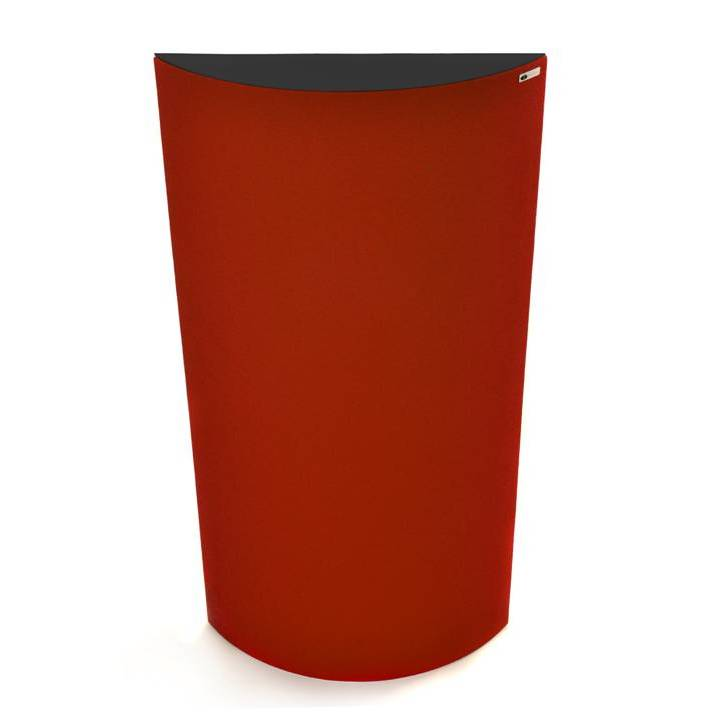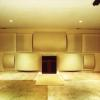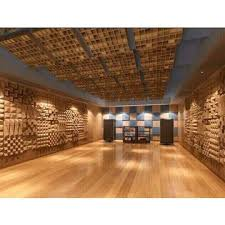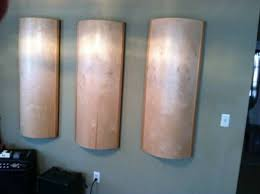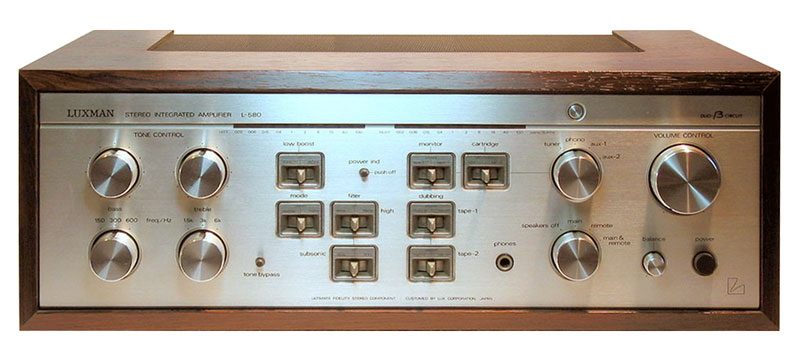-
Posts
4186 -
Joined
-
Last visited
Content Type
Forums
Events
Gallery
Everything posted by garyrc
-
On the British TV show Repair Shop, they rebuilt an old, wind up, gramophone that had a large horn. They said the acceptable way to make it less loud was to stuff cloth into the horn. They said that was the origin of, "Put a sock in it!"
-
https://www.amazon.com/Building-Recording-Studio-Jeff-Cooper/dp/0916899004 At you local library, or used for about $25. The new price is ridiculous ... This book is oriented toward building a home studio. Same principles for a listening room. We used it to build a smallish listening room in our old home. We had floating floor, etc, but the deep loud bass from Klipschorns went through anyway. In our newer home, we used a simpler build. I recommend a combination of absorption and diffusion. Don't over-deaden.
-
Luxman Solid State or Vacuum Tubes Amplifier
garyrc replied to Vivek Batra's topic in 2-Channel Home Audio
My guess is that Klipsch, knowing that speakers are listened to in a room, rather than In an anechoic chamber, publishes their sensitivity as it would be in a room. There is a tiny number in superscript next to their ratings, that leads the reader to the footnote, "Sensitivity in an average listening room." The AES speaker positioning of any of the Heritage speakers would be inappropriate for listening. A Klipsch engineer on this forum said the difference is about 4 dB. I understand this is convenient for Klipsch, and may have come from the PR department, but it also is reality based, in a way. Klipsch's sensitivity ratings pre-dated the current standards. For instance, they used to spec the Klipschorn at "104 dB at 4 feet at 1 w," or 54 dB using an EIA rating. The slow constellations wheeled on. In modern times, moving from 4 feet to 1m, (3.28 feet), about 8.6" closer -- therefore louder -- probably increases SPL by an amount that rounds off to 1 dB, so they were rated at 105 dB at 1m at 1w (2.83v into 8 ohms). Actual measurements were probably taken at a much more distant spot, to let the speakers integrate, then they did the math. In those days, Paul Klipsch recommended that all speakers be placed in, or very near, a corner. That amounted to "Manufacturer's Instructions," which is where the speakers should be placed and measured. Moving a speaker from out in a room into a corner produces an increase of 6 dB or more. [Certainly, an older K-horn, without a sealed back should be measured in 1/8 space, i.e. sealed (with rubber, or the like) in a trihedral corner. It is recommended that even the new K-horns, with their factory sealed backs, still be placed in the close proximity of a corner, but now can be toed toward the listeners. This didn't stop Stereophile from -- impertinently, both meanings intended -- measuring them outside, not in a corner, raised off a driveway on a furniture dolly. Even then, they got 101 dB, 1m, 2.83v, exactly 4 dB below Klipsch's in-room result.] The entire (original) Heritage line all may benefit from being in a corner, providing that a few absorbers are placed to prevent nearfield reflections of the midrange from the side walls. See @Chris A, "Corner horn imaging" on this forum. -
Luxman Solid State or Vacuum Tubes Amplifier
garyrc replied to Vivek Batra's topic in 2-Channel Home Audio
I had a Luxman years ago. I was introduced to it as "the McIntosh of Japan." It was warm and wonderful. -
Welcome to the forum! Is it really a Klipsch Heritage? The new Klipsch Heritage wireless have designations like One, Three, Six, etc., then there are the marvelous Heritage speakers designed by Paul Klipsch, like the mighty Klipschorn. I googled Heritage BT, and couldn't find a BT without a number attached, even in the New Zealand line called Heritage, but not made by Klipsch. Does your Mee Audio thing have their Volume Boost feature?
-
Some of them are available from GIK Acoustics, including one of the two I like best, for visual aesthetics, the Gotham thing. I know nothing about the acoustical characteristics, other than what they, and other sources (companies and journal articles on Google), say. I like the idea of 2 dimension diffusers, i.e., both right/left and up/down in the same diffuser. https://www.gikacoustics.com/product/gotham-n23-5-inch-quadratic-diffusors/ They also make a poly that resembles the ones PWK put DIY plans for (a la Dr Bonner) on The Dope from Hope many years ago. As you probably know, forum member Artto did a great room with a spate of these -- look him up here. I would think that several sizes and several orientations, as Artto used, would be preferred. IIRC, Artto had some choice nouns and adjectives for the idea that polycylindrical diffusers aren't really diffusers. I've read that some kinds of diffusors need to be at a greater distance than others --- the only one I happen to remember had the term "bright screen" in it's description. All I have are book shelves with art objects ("polydimensional" ☺️) and these and a few absorbers and a thick rug. Nobody seems to know whether these devices are spelled diffusors or diffusers. Failure to type the word "acoustical" before either spelling produces atomizers, also blessed with two spellings.
-
Very, very good point. Seymour makes some good acoustically transparent screens. If you go that route, mount the projector as far away as possible (i.e., on the back wall), so that the focus won't be as hard to do. Ours is about 23 feet away, and it's great.
-
@Battletroll I just noticed that no one has answered you in a month and 1/2. Sorry about that. Or, did you duplicate your post on some other thread? I'll take a look. [moved from architectural] Ah, here you are! Here is my take: Ask Klipsch support, as well as us. You may want to crossover to your sub at a higher frequency than the typical 80 Hz to keep the high intensity bass out of the in-wall speakers. Things to think about: What is the volume of your room in cu.ft.? If you have an 8' ceiling, your room volume would be about 1,941 cu. ft. Will your room be acoustically live, medium, or dead? How far away from the front speakers will you sit? " " " " the subwoofer " " " Would you say you will play movies: Loudly? Medium level? Low level? THX, for a room your size (if you have an 8' ceiling, and medium liveness), modifies its recommended PEAK levels due to the influence of early reflections, which make these lower peak levels SOUND LIKE THX reference level peaks in a commercial movie theater, even though they are 7 dB lower. So, instead of 105 dB full scale (loudest peaks) through each regular speaker, they recommend 98 dB peaks at your ears, and instead of 115 dB full scale (loudest peaks) through the subwoofer, they recommend 108 dB peaks at your ears. Indoors in a room of average liveness, you lose about 3 dB for each doubling of distance (not the 6 dB loss per doubling you would get outside, with no walls). So, if you have speakers of 92 dB, 2.83v, 1m sensitivity (= 92 db, 1w, 1m into 8 ohms), and you sit 4 m (about 13' 2" ) away from the front speakers, that's 2 doublings, indoors, so your 1 watt needed for 92 dB transforms into 4 watts needed at 13 feet for the same 92 dB. But you need 98 dB peaks through each main speaker for something that SOUNDS LIKE reference level in your small room. So, for just a very brief time, you will need 6 dB more through each main speaker for a maximum instantaneous peak. For you, that would be 16 watts, since for each 3 dB increase you need to double the wattage. So, if your main speakers can really take 75 watts "continuous" power [perhaps what is slightly incorrectly nicknamed "RMS," power, perhaps not], then I would feel confident it would take instantaneous peaks of 16 watts, or even 32 watts, to build in a safety factor. Subwoofers are a whole different animal, since they have their own built-in amplifier, and the sensitivity of the speakers inside is almost never given. Look at the "Maximum SPL," and remember that is probably at 1 meter away, so do your calculations. Why then do we hear about blown speakers? Film buffs go wild an play louder than reference, or incorrectly predict a peak that is coming, or practice volume riding and blow it. Filmmakers go wild. They can't change the full scale peak level, fs, on the film or the Blu-ray disk, but they can record most of the film softly, to trick you into turning up the volume, permitting higher (dramatic!) peaks than you are expecting. Watch out for the bass at the beginning of Edge of Tommorrow, I think it's called. Action picture excess can be a problem, especially through the subwoofer, but things like gunfire often have a leading edge of a peak up in the range of the main speakers. People set their main speakers for "Large." Don't do this, even if you end up getting physically large speakers. Set all speakers to "Small," sending the deep bass to the sub only, letting it do the heavy lifting. Frequency sweeps or test signals are sent through at too high a volume. Some tweeters, especially, are very delicate, and will only take a few watts. In music, these frequencies are as much as 15 to 20 dB below the lower mids and bass, but not in test signals! Most AVReceivvers are power rated quite misleadingly (compared to a separate power amp). I'm assuming that your AVR (if that's what you have) is rated at 150 watts per channel. The honest way to rate them is at 20 to 20,000 Hz, all channels operating (to properly stress the power supply), into 8 ohms, at a low distortion level (usually @ < 0.1%). Almost no AVR manufacturer does that, unless that spec is buried and in fine print. The truth can be seen in some bench tests by magazines like Home Theater or, occasionally, Stereophile. Many of the more acceptable AVRs will fudge the spec to "with 2 channels operating." Long ago, somebody here suggested that, on the average, a name brand AVR with a 2 channels operating spec would put out about 70 to 80% of the rated power with 5 channels operating. Who cares? You don't want the AVR clipping, due to not enough power, because most people here (not all) think that is very hard on tweeters. Must run ... you might want to check my hurriedly done math.
-
@Battletroll I just noticed that no one has answered you in a month and 1/2. Sorry about that. Or, did you duplicate your post on some other thread? I'll take a look. Ask Klipsch support, as well as us. You may want to crossover to your sub at a higher frequency than the typical 80 Hz to keep the high intensity bass out of the in-wall speakers. Things to think about: What is the volume of your room in cu.ft.? If you have an 8' ceiling, your room volume would be about 1,941 cu. ft. Will your room be acoustically live, medium, or dead? How far away from the front speakers will you sit? " " " " the subwoofer " " " Would you say you will play movies: Loudly? Medium level? Low level? THX, for a room your size (if you have an 8' ceiling, and medium liveness), modifies its recommended PEAK levels due to the influence of early reflections, which make these lower peak levels SOUND LIKE THX reference level peaks in a commercial movie theater, even though they are 7 dB lower. So, instead of 105 dB full scale (loudest peaks) through each regular speaker, they recommend 98 dB peaks at your ears, and instead of 115 dB full scale (loudest peaks) through the subwoofer, they recommend 108 dB peaks at your ears. Indoors in a room of average liveness, you lose about 3 dB for each doubling of distance (not the 6 dB loss per doubling you would get outside, with no walls). So, if you have speakers of 92 dB, 2.83v, 1m sensitivity (= 92 db, 1w, 1m into 8 ohms), and you sit 4 m (about 13' 2" ) away from the front speakers, that's 2 doublings, indoors, so your 1 watt needed for 92 dB transforms into 4 watts needed at 13 feet for the same 92 dB. But you need 98 dB peaks through each main speaker for something that SOUNDS LIKE reference level in your small room. So, for just a very brief time, you will need 6 dB more through each main speaker for a maximum instantaneous peak. For you, that would be 16 watts, since for each 3 dB increase you need to double the wattage. So, if your main speakers can really take 75 watts "continuous" power [perhaps what is slightly incorrectly nicknamed "RMS," power, perhaps not], then I would feel confident it would take instantaneous peaks of 16 watts, or even 32 watts, to build in a safety factor. Subwoofers are a whole different animal, since they have their own built-in amplifier, and the sensitivity of the speakers inside is almost never given. Look at the "Maximum SPL," and remember that is probably at 1 meter away, so do your calculations. Why then do we heat about blown speakers? Film buffs go wild an play louder than reference, or incorrectly predict a peak that is coming, or practice volume riding and blow it. Filmmakers go wild. They can't change the full scale peak level, fs, on the film or the Blu-ray disk, but they can record most of the film softly, to trick you into turning up the volume, permitting higher (dramatic!) peaks than you are expecting. Watch out for the bass at the beginning of Edge of Tommorrow, I think it's called. Action picture excess can be a problem, especially through the subwoofer, but things like gunfire often have a leading edge of a peak up in the range of the main speakers. People set their main speakers for "Large." Don't do this, even if you end up getting physically large speakers. Set all speakers to "Small," sending the deep bass to the sub only, letting it do the heavy lifting. Frequency sweeps or test signals are sent through at too high a volume. Some tweeters, especially, are very delicate, and will only take a few watts. In music, these frequencies are as much as 15 to 20 dB below the lower mids and bass, but not in test signals! Most AVReceivvers are power rated quite misleadingly (compared to a separate power amp). I'm assuming that your AVR (if that's what you have) is rated at 150 watts per channel. The honest way to rate them is at 20 to 20,000 Hz, all channels operating (to properly stress the power supply), into 8 ohms, at a low distortion level (usually @ < 0.1%). Almost no AVR manufacturer does that, unless that spec is buried and in fine print. The truth can be seen in some bench tests by magazines like Home Theater or, occasionally, Stereophile. Many of the more acceptable AVRs will fudge the spec to "with 2 channels operating." Long ago, somebody here suggested that, on the average, a name brand AVR with a 2 channels operating spec would put out about 70 to 80% of the rated power with 5 channels operating. Who cares? You don't want the AVR clipping, due to not enough power, because most people here (not all) think that is very hard on tweeters. Must run ... you might want to check my hurriedly done math.
- 1 reply
-
- 1
-

-
@schwock5, IMO, you are getting excellent advice from @audioquest4life, and others, and you already know a lot. Did anyone mention staggering the seams when you put up your two layers of gypsum board with green glue? During most of my life, there was a distinct difference between "damping" and "dampening." But google has convinced me that the battle has been lost, and the one time error, probably first committed on Star Trek, is now not, and the two words can be used interchangeably. So, we have lost a definition once again, as we did in the cases of "factoid," "overachiever," "schizophrenia," "negative reinforcement," "Hi Fi," "stereophonic," "RMS," "unconscious," "subsonic," "widescreen," "Christian," "anarchism," "professional," and, no doubt, dozens of others. But, I politely decline to speak of an amplifier's "dampening factor." That's O.K., in my parents' generation google was a guy named Barney who had very big eyes, and probably dampened his bed.
-
Or deaden half of the area behind the sofa, and put diffusers on the other half(?). Stagger them, checker board style. Your beautiful room is already pretty bold, this would make it bolder. Some diffusers look pretty good. You might be able to paint or stain them to match the wall color, or to make an interesting contrast. How far is the sofa from the rear wall? Some Rock, Pop, and Metal recordings have the bass turned down, the upper midrange turned up, and the highest overtones turned down.. It is a crazy recording industry practice. They will sound harsh on a relatively honest speaker system. For the reasons, see Chris A's threads on de-mastering. To the degree it is a matter of balance, turning up the sub a bit may help. If you crossover to the sub at 80 Hz, you may still need some upper bass boost (~~80 Hz to ~~200 Hz) as well. The tone controls on your AVR should take care of this. In my experience, Classical and Jazz are not as bad, and often pretty good. Blu-rays are usually superb.
-
Whatever you get, your center may need to be turned up about 3 dB to make poorly recorded dialogue clearer.
-
Welcome! Put some thick, non-distracting (I'd think dark in color and skid proof) area rugs ("throw rugs") on the beautiful hardwood floor at the point at which the tweeter sound hits the floor and bounces off right into the listener's ears. A way to determine just where this "first reflection point" is is to temporrarily put a mirror flat on the floor and have someone else move it around while you sit at the Main Listening Position (MLP) or, for a larger audience, at each of the Listening Positions (LPs), and wherever you see the reflection of any speaker, put an area rug right where the mirror was.. Normally, you would put absorbers on the walls at their first reflection points, as well, but your walls just might be far enough away so I'd make changes one, or a few, at a time, and see what happens. Thick drapes might help. Close while listening. Don't over deaden. An over-dead room sounds just as bad as an over-live one. Your room has many complex shapes in it, which might provide rich, GOOD reverberation, once you get the harshness out. Coffee tables are often a problem. Thick cloth covers, or partial covers, sometimes help. You might want to add to the acoustical complexity by putting in some attractive diffusors, as well. What you want to avoid are "slap back" echos, specular reflections, etc. Do you happen to have a Marantz or Denon AV Receiver or AV Preamp-processor? If so, AFTER you acoustically treat the room, run Audyssey to make what are usually positive changes in EQ and the handling of the time domain. Some older models of other brands have Audyssey, too. If that's what you have, read this first: "Audyssey FAQ Linked Here" Audyssey removed a peak at 8K in my Klipschorn tweeter, and smoothed out the rest of the treble and midrange. Almost all users of Audyssey end up turning up their subwoofers a bit AFTER using it, because Audyssey gives you Reference, not Preference, and most of us like our bass. If you have NAD, it might have Dirac. There are several levels of this. I don't know if NAD provides a high level, but the highest levels are purported to be even better than Audyssey. How many watts per channel do you have, both main channels operating, 20 to 20K, at distortion below about 0.1%? It is extremely unlikely that your receiver or amplifier is clipping, given the sensitivity of your speakers, but since your room is large and has a connecting room, I thought I'd ask.
-
Yes or no: are the RP260s/ 280s too big for a 13x13 room?
garyrc replied to Man in the Box's topic in General Klipsch Info
Is your room really perfectly square (13 x 13)? A square room can be a problem in that both dimensions can reinforce the same standing waves. Someone might recommend a bass-trap. Does your system have Audyssey or some other electronic room optimizer? They are often in AV receivers, or in AV preamp-processors. Use that AFTER you finish treating the room. Don't over deaden the room. BEFORE you run an electronic room optimizer, try raising and lowering the crossover to the sub, and see if that helps. The typical crossover to a sub is 80 Hz, but sometimes a different frequency is better. Get the biggest speaker in the line you like. I had Klipschorns in a room 9 x 12, and they were good, but not as good as they were in their current very big room. -
Dynamics and the leaning edge of big peaks. Back when I had a small room (about 1,000 cu ft) & Khorns, the built-in meter in my Yamaha power amp usually read less than a watt or two, but 6.3 watts on very loud, very brief, peaks. Once, though, at the end of a Mahler symphony, at a realistic level, it reached 25 watts for just a moment. For the last 15 years, I have had a large room (4,257 cu. ft.) & Khorns, along with a Belle center, and Heresy II surrounds and crossing over at 80 Hz to a Klipsch RSW15 sub, with all kinds of boundary gain, to play PWK's Wide Stage Stereo (3 channels), or SACD Multichannel music (5.0 or 5.1), or Blu-rays (5.1). I no longer use a power in watts meter, but with an SPL meter, C wt., "Fast," big, unusual, very brief peaks in music very occasionally reach 110 dB for just an instant (this would be at the end of The Great Gate of Kiev, or the Crystal Clear Records version of Fanfare for the Common Man -- not the brass, but the tympani, bass drum, Tam-Tam, etc. -- and Mahler, again). For explosions in movies, a reading of 115 dB is conceivable, since that is THX's fs for the sub channel. It's doubtful, though, because I always set movie SPL for normal dialog (not screaming or whispering) ASAP in the film, and that dialog usually ranges from the mid '70s in dB to the mid '80s. This results in a Main Volume setting of 5 to 7 dB below THX/Dolby/Cinema reference level, as set in an Audyssey calibration. In my THX portfolio, it states that the greatest SPL recorded 1/2 way back in their test theater for The Empire Strikes Back was 110 dB in the bass, with a nominal test SPL (I refuse to call it an average!) of 88 dB (rather than the 85 dB settled on later, to allow for 20 dB peaks up to the fs of 105 dB when above 80 Hz, and 115 dB below 80 Hz). For movies, my usual 5 to 7 dB below reference, set for dialog, gives me about 110 dB below 80 Hz, and 100 dB above 80 Hz. Un-coincidentally, that gives me THX peak levels for a room my size (for home-sized rooms, because of early reflections, and other "small" room phenomena, THX reduces their recommended level); at this lower level, in the small room, the movies "sound like" they have theatrical level brief peaks, even though they are 5 to 7 dB lower in measured SPL. At 13 feet away from the listener in my 4,257 cu.ft. room, it takes just below 4 watts through 1 Khorn to produce 100 dB. If I were to put the bass below 80 Hz through the Khorn (which I don't, except for the slope the crossover to the sub allows) and produce the needed 110 dB, 1 Khorn would take about 32 watts. But this is neither here nor there -- who knows how many watts the sub is requiring from its built-in, 650 watt continuous, 2,400 watt "dynamic power" amplifier? I hear no clipping. As many of us know, SPL is the hopefully objectively measured physical pressure at the location of the meter (or the ears), loudness is a perceptual phenomenon, influenced by many factors, and volume originally meant volume! In a room of high volume in cubic feet, one would turn up the control marked volume, and in a less voluminous room, one would turn that knob down. Instantaneous peaks of 100 dB probably wouldn't bother OSHA much; they allow much more continuous machine noise at that level for 2 hours! Likewise, 110 dB is allowed for 1/2 hour, and even 115 dB for 1/4 hour.
-
Luxman had some cabinets like that, but the ones I've seen didn't have a trapezoidal vent. They may have gone trapezoidal in another model. This is the L-580 -- best solid state I ever had, and the most versatile.
-
Best Klipsch Speaker Settings for 5.1 system.
garyrc replied to Celtics1's topic in Technical/Restorations
Welcome to the forum! Install any acoustical room treatments (tapestries, rugs, absorbers, diffusers, art objects, etc) before doing the rest of this list. There should be a direct line, without obstructions, to your ears from each speaker (except the sub). It is best to not have a coffee table in front of you, but many live with one, or with a coffee table advocate. If you do have one, it's better to have it covered with something cloth. Attend some live concerts, especially of non-reinforced acoustical music, if you can, before finalizing your set up. Paul W. Klipsch advocated thus re-calibrating your ears. Toe in the speakers so you are looking down the throat of each tweeter -- at least start with that orientation, and see what you think on a variety of movies and music, but don't listen until you have done everything else on this list. If your center speaker is on a table, pull it forward until it's cabinet is about 1" beyond the top of the table, hanging over. The overhang prevents early reflections from interfering with dialog (and music) clarity. Set all speakers (except subwoofers, of course) for "SMALL." Set all crosovvers for 80 Hz, to start with. I think you have Audyssey -- do you? If so, run Audyssey, using all of the recommended microphone positions (usually 8). Most of us, having gotten used to a few bass peaks in our room, end up turning up the subwoofer a few dB (say 3 to 6) AFTER running Audyssey. Turning it up before won't help, because Audyssey will dutifully turn it down again. Audyssey takes patience, but my Klipschorns have never sounded so good! Audyssey really helps. Listen to movies and music for about a week, and see what you think. Most people end up making a few adjustments to achieve their Preference. Audyssey sets your system to Reference, not Preference. But feel free to adjust the subwoofer volume (at the control on the sub itself -- keep the sub trim in the AVR low to avoid distortion. The little line drivers in most AVRs clip, or produce pre-clipping distortion easily. When you get to the adjustment for Preference stage, you will be much better off having run Audyssey, because you will be starting with a relatively smooth frequency response curve, instead of a kinky one -- unless you like kinky. Don't make any rapid judgements. Let music of various kinds flow over you for a week or more before making any changes. Audyssey can range from easy to difficult set up. Some people give up way too early, IMO. Don't be one of them! The rewards are great! Give yourself about 45 minutes to read through the following. It is far better than any manual I've seen. It was written by a master of clarity and it went through the editing of dozens of hobbyists and professionals. "Audyssey FAQ Linked Here" After you have given yourself a rest from reading, consider reading this one. It has a Cliff Notes section, and was written by another master. GUIDE TO SUBWOOFER CALIBRATION AND BASS PREFERENCES * The Guide linked above is a comprehensive guide to Audio & HT systems, including: Speaker placements & Room treatments; HT calibration & Room EQ; Room gain; Bass Preferences; Subwoofer Buyer's Guide: Sealed/ported; ID subs; Subwoofer placement. Best of Luck! -
Belle extreme slope crossover schematic
garyrc replied to Erniebear's topic in Technical/Restorations
What slopes did the AB3 have? -
HT Receiver Upgrade, Or is it? (Pioneer vs Marantz)
garyrc replied to EdmundGTP's topic in Home Theater
Go for the Marantz. The biggest single advantage you'll get is Audyssey XT32, if you have the time and patience to set it up correctly. My Klipschorns have never sounded so good as they do with Audyssey (the Audyssey Flat option, without dynamic EQ and without dynamic volume). Having my speakers and room EQ'd over hundreds of points by Audyssey improved the sound greatly. Here's what I would recommend: Get the Marantz Install any room treatments (a carpet or area rugs if you don't already have one or the other, plus some absorbers and diffusers or diffusing furniture, art objects, what-have-you). Run Audyssey XT32, with all 8 microphone positions. First read this "Audyssey FAQ Linked Here" -- it is an accesable, relatively quick read, in easy to read question and answer format. Then, at your leisure, read this. GUIDE TO SUBWOOFER CALIBRATION AND BASS PREFERENCES * The Guide linked above is a comprehensive guide to Audio & HT systems, including: Speaker placements & Room treatments; HT calibration & Room EQ; Room gain; Bass Preferences; Subwoofer Buyer's Guide: Sealed/ported; ID subs; Subwoofer placement. It is the be-all and end-all, and a bit more up to date than the first one. As mentioned in both of those guides, most people will want to turn up the bass 3 to 6 dB (in a few cases even more) after running Audyssey, for the reasons given. It is so much better to impose your preference with a largely kink free curve (provided by Audyssey) than it is with a typical room curve. -
Thanks for this, @babadono. For many of us in the SF Bay Area, Joe Minor was a beloved resource. In his little "hole in the wall" store in Berkeley, and his engineering room next door, we spent many happy hours listening to Klipschorns, JBLs, 1 Bozak, etc. The Khorns were the best of the bunch. I believe he was the first Klipsch dealer in the Bay Area, and people would drive long distances to hear his demos. He loaned us equipment, and helped us design custom rooms, and expounded on myriad topics, audio and not. He attracted young engineers who graduated from his store and went on to help develop the field. One was John Curl (later famed Parasound design engineer). Another was Don Helmholts, who went on to co-found Pro Audio in Oakland, another wellspring, and who built me a little mixer when I couldn't afford a board. I'm glad Joe introduced Arthur Fiedler to Klipschorns, as well. The dealer/educators, in brick and mortar academies, with whom we can hang out, are a vanishing breed. I had Joe, John, and Don of Berkeley/Oakland, and Jim Ott of Oregon. The text of the Klipsch ad discovered by babadono: ARTHUR FIEDLER INTERNATIONALLY NOTED CONDUCTOR "For my own listening pleasure at home, l like the Klipschorn. It has wide range, clarity and exceptional definition." ABOUT THE MAN -Eminent in music circles as Conductor of Boston POPS Orchestra Boston Esplanade Concerts San Francisco Summer Symphony Concerts R.C.A. Victor Red Seal Recording Artist. HOW IT HAPPENED -While conducting a series of concerts with the San Francisco Symphony Orchestra in mid summer, Conductor Arthur Fiedler heard a demonstration of the Klipschorn, with custom engineered audio amplification by engineer Joe Minor of Berkeley Custom Electronics, in Berkeley, California. Impressed, Arthur Fiedler reaffirmed his admiration for the Klispchorn and now, at his home in Boston, enjoys his -own with similarly engineered amplification. KLIPSCH & ASSOCIATES
-
An Audio moment ... several! 1) The first time I heard 6 channel magnetic stereo in a 70mm movie. The theater used huge JBLs, commissioned by Ampex, the designer of the rest of the Todd-AO sound system (I asked). It sounded like the school orchestra I played in. Incredible dynamics and openness! 2) Trying to duplicate the above, and failing, but the JBL C55 with the same drivers that were in the theater, but different horns, was at least reminiscent of the theater system, but very little bass (bass horn too small?), and mono. Still, it was spectacularly better than any of my friends or their parents had. 3) Found a Bozak system that had more bass and was sweeter sounding, but without the airiness and the cortex tingling brass. No sale. 4) Discovered Klipschorns with a Belle Klipsch third (center) channel, PWK's "Wide Stage Stereo.". They sounded "free floating," as a friend put it, and balanced, with the incredible dynamics of the theater system. Then followed an approx 20 year period of saving pennies, and gradually moving to better and better jobs, until 1982 when they became mine. I listened to everything I could, once again, and the Khorns came out on top, again. As J. Gordon Holt reported, Khorns triggered his readers "musical gestalt," and they certainly triggered mine. There were several other speakers that were about as good -- but very different -- sometimes much more expensive and needing > 3,000 watts per channel to match 100 w.p.c. into the Klipschorns [B & W 801F rated at 85w, 2.83v, 1m vs Khorn rated at 101w (conservative), 2.83v, 1m]. But none had the openness and the great brass, percussion, and dynamics. Now, with a stock upgrade (AK-4), they are the front array of our 5.1 movie system, and also our music listening system with either 2 ch or a 5.1 system with SACD, DVD-A, or Blu-ray. With some Blu-rays, it equals the 70mm theater system. I think.
-
12 different prescription meds -- will possibly be fewer in the future, if I can get beyond a couple of illness (nothing death dealing). 4 different kinds of vitamin, mineral, omega 3 pills. My wife and I exercise to music, from In-A-Gadda-Da-Vida to Beethoven (esp the finale of the 7th). We found that the music helps us exercise regularly (without, not successful). We were in our teens and twenties in the 1960s. I had brewer's yeast, wheat germ, cashew butter, carrot juice (sometimes Ma Revolution brand, with a Granny holding a shotgun on the label), and vitamin supplements, etc. from the Food Mill (Oakland's landmark organic food store). We were both non-smokers and light drinkers, but partook sparingly of the weed. One or the other of us may have tried the magic mushroom, niacin, etc. From To
-
How to record live baroque ensembe PWK-style? Advice requested
garyrc replied to MeloManiac's topic in Ask the Historian
I heard that Fine and company, when recording the Mercury 35 mm full coat 3 channel magnetic film (the polar opposite of execrable mp3) would ask the orchestra to play what they thought was the very loudest passage in the work, and set the record level so that the meters didn't quite go into the red. They would also listen to a playback of that loud passage, to make sure they didn't hear a problem, because sometimes meters are not as good as the human ear. They claimed "Full Dynamic Range," even though they would record at a level a little lower than normal (to avoid distortion). This is plausible, because 35mm mag film with three tracks, each of which was wider than a stereo tape track of those days (c. 1962), had lower hiss than the tape used by most other recordists. Modern high quality digital (WAV???) should be even better. I always used that level setting technique, but would choose three maximum level samples to set it, because I doubted our ability to pick the very loudest by ear. Can you transport the participants to a good sounding church or cathedral for natural reverb? The best place I ever recorded was the Congregational Church in downtown San Francisco, but that's a little far for all of you to travel. -
Different locations in the room produce different bass characteristics. Put your right speaker where the left one is now, and vice versa, and see if the bass problem follows the bass-shy speaker. If it does, it may be the speaker. If it doesn't it may be the room's "boundary gain." Paul Klipsch recommended putting La Scalas in corners for maximum boundary gain. If a La Scala is out in the room (where some "audiophiles" put their speakers), away from any walls, and is moved to a position against a wall, actually almost touching the wall, a gain of about 3 dB, mostly in the bass, should happen. If it is then moved into a corner, almost touching, you should get another 3 dB or so. So that's a total increase of 6 dB, mostly in the bass. Since the power demand in music is often greatest in the bass (even if you use a sub below about 80 Hz, there is plenty of bass power needed between 80 Hz and 160 Hz where the leading edge of bass attacks occur) the boundary gain is useful, and as PWK said, it is like exchanging a 100 watt amplifier for a 400 watt amplifier, without extra strain on the speaker.
-
New member: Looking at AK6 Klipschorns, any owners? ,
garyrc replied to audioquest4life's topic in 2-Channel Home Audio
Welcome to the forum! The Jubilee was originally intended to be the "New Klipschorn." Paul Klipsch worked on it. After Paul's death at about 97/98 years old, chief engineer Roy Delgado continued to refine it. It is meant to be an "Uber music horn." See Chris A"s many posts here, particularly this one: https://community.klipsch.com/index.php?/topic/182997-an-unofficial-klipsch-jubilee-buyers-guide/&tab=comments#comment-2374191 Chris is a great resource, and needless to say has Jubilees. Don't get me wrong, I have Klipschorns, and love them! I'm listening to the Firebird on them right now, and they sound so much like the various orchestras I've played in, it's amazing. I use them for both music listening and home theater -- with Audyssey and painstaking set-up they sound great. My wife thinks they both look and sound beautiful! Both the new Klipschorns and the Jubilees have closed backs, BUT, they should be in corners, very close to the walls. An air tight seal is no longer needed, so they can be toed in toward the listener. Is there a link to the article reviewing Klipschorns in the German magazine Audio that you could send us? I don't seem to be able to find it here. Thanks.



